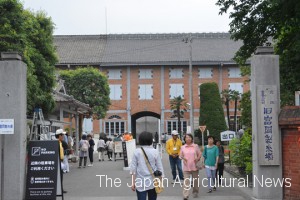Cooperatives one after another established in raw silk and tea sector
In legal basis, sangyokumiai(cooperatives) started in 1900 (Meiji 33). However, before legislation of sangyokumiai, there were some cooperatives which had been born spontaneously and had the same character as sangyokumiai. At the early Meiji era, initial movement of voluntary cooperatives began in the sector of selling cooperatives of raw silk and tea, which were two major exports at that time.
In 1859 (Ansei 6), owing to open of Yokohama port, the way of raw silk export was opened. As the proliferation of export, production could not keep up with the demand, overproduction of inferior goods was so flagrant. Uniform thing of quality was desired in a large amount, but, there were lots of raw silk products which could not fully respond to this request. There were also some raw silk wholesalers who did not have store and sold the raw silk of uneven quality to Yokohama merchants. Trust of quality was reduced, price of raw silk declined, and silk related merchants became bankruptcy one after another.

Government Controlled Tomioka Silk Mill (World Heritage Site registered in June 2014), which specialized in machinery silk and started operation in Tomioka city in 1872 (Meiji 5). Joshu south three companies did not refer as the model.
The government rushed construction of Government Controlled Tomioka Silk Mill. Government Controlled Tomioka Silk Mill (Tomioka city, Gunma prefecture), specialized in machinery silk, started operation in Tomioka city in 1872 (Meiji 5).
In the southwest area of Gunma Prefecture (Minamijosyu), sericulture had been thrived from the Edo era. “Maebashi yarn” and “Shimonita yarn ” produced there had been once praised by foreigners.
In 1869 (Meiji 2), Three years before Tomioka Silk Mill started, the Italian envoy row visited Nagano Prefecture and Gunma prefecture where sericulture reeling had been thriving. In the report, while pointing out the problems of the current situation of sericulture reeling, they proposed “to respond to foreign raw silk, you need the introduction of instruments reeling that can unification of quality.”
Silk became major export products by improvement of the quality
The first organization equipped with cooperatives character in Gunma prefecture was Usuisha (Annaka city). Otokichi Hagiwara, raw silk merchant, knew that spinning original company was born in Maebashi town (current Maebashi city) and told that to Ryotaro Hagiwara in charge of assistant Mayor.
Ryotaro, wealthy farmer engaged in sericulture, was aware that it was difficult to uniform the quality of silk by Zakuriseishi (hand reeling filature) so that production volume was not enough for raising price up to reasonable level.
He learned the technology and the organization of advanced “Maebashi seishi gensha (Maebashi reeling company)”. Using it as a model, he established reeling cooperatives called “Usui zakuri seishisha (Usui hand reeling filature company)” (later Usuisha) with Otokichi in 1878 (Meiji 11). The purpose of cooperatives was to co-sell raw silk in order to improve the economic situation of sericulture reeling farmers.

Exhibition of Zakuriseishi (hand reeling filature) using the doll (collection of Tomioka Municipal Art Museum, Gunma prefecture)
However, without the introduction of instruments such as the Tomioka Silk Mill, the company continued repeatedly improved hand reeling filature. Because, for farmers, sericulture reeling activity was sidelining to do during farming, so that it was thought to be not amenable to mechanization. In addition, weaving was in many cases to do in the house, farmers had the attachment to a series of work from the cocoon to the kimono (Japanese clothes).
This basic recognition became big factor that improved hand reeling filature continued repeatedly from the traditional, without the model of the state-run Tomioka Silk Mill to buy cocoon and operate reeling by division of labor. (Mikio Imai, “Tomioka Silk Mill and Minamisansha (south three companies)”, published by Silk Country Sosho)
Ryotaro had been used to say proudly, “Except for us, there is no other example that small company pays full amount to employees after subtracting corporate expenses. So, we can welcome more and more members,” “It is the purpose of cooperatives of reeling to rescue individual silk house struggled under pressure of price down by brokerage.” He was the man deeply understanding the heart of the cooperatives.
In 1880 (Meiji 13), Kita kanra reeling company (Kanrasha) was established. Usuisha, Kanrasha and Shimonitasha separated from Kanrasha in 1893 (Meiji 26) are called as “Joshu mianmisansha (Joshu south three companies).” Three companies used method of improved hand reeling filature different from instruments reeling.
Cooperatives of reeling were established in various places. Kaimeisha of Nagano prefecture, Kusanagisha of Yamanashi prefecture, Kaishinsha of Saitama prefecture, Zenshinsha of Kanagawa prefecture, and Hikamikyodosha of Hyogo prefecture are known.
◇
The sales cooperatives of tea were also established for measures to the problem of overproduction of inferior goods. The cooperatives aimed for improving the quality of the tea, and excluding the failure brokerage, so as to recover the credit recovery in overseas markets. In Shizuoka prefecture, co-sales business was executed among merchants. Iwatasha was established in 1877 (Meiji 10) but disbanded two years later. Only Ekishusha lasted until enactment of the Sangyokumiai (cooperatives) Law.

